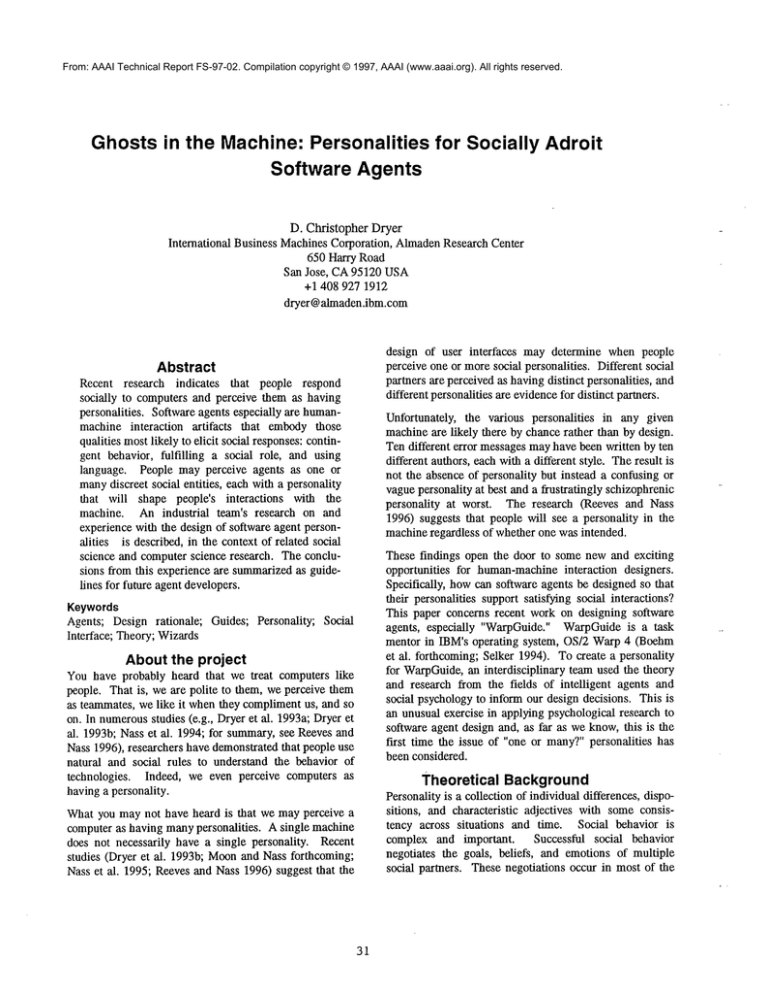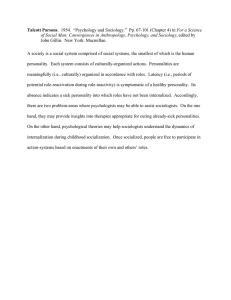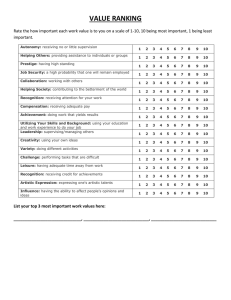
From: AAAI Technical Report FS-97-02. Compilation copyright © 1997, AAAI (www.aaai.org). All rights reserved.
Ghostsin the Machine:Personalities for Socially Adroit
Software Agents
D. Christopher Dryer
International Business MachinesCorporation, AlmadenResearch Center
650 Harry Road
San Jose, CA95120 USA
+1 408 927 1912
dryer @almaden.ibm,com
design of user interfaces may determine when people
perceive one or moresocial personalities. Different social
partners are perceivedas havingdistinct personalities, and
different personalities are evidencefor distinct parmers.
Abstract
Recent research indicates that people respond
socially to computers and perceive them as having
personalities. Softwareagents especially are humanmachine interaction artifacts that embodythose
qualities mostlikely to elicit social responses:contingent behavior, fulfilling a social role, and using
language. People may perceive agents as one or
manydiscreet social entities, each with a personality
that will shape people’s interactions with the
machine. An industrial team’s research on and
experience with the design of software agent personalities is described, in the context of related social
science and computerscience research. The conclusions from this experience are summarizedas guidelines for future agent developers.
Unfortunately, the various personalities in any given
machineare likely there by chancerather than by design.
Ten different error messagesmayhave been written by ten
different authors, each witha different style. Theresult is
not the absence of personality but instead a confusing or
vaguepersonality at best and a frustratingly schizophrenic
personality at worst. The research (Reeves and Nass
1996) suggests that people will see a personality in the
machineregardless of whether one was intended.
Keywords
Agents; Design rationale; Guides; Personality; Social
Interface; Theory; Wizards
Aboutthe project
You have probably heard that we treat computers like
people. That is, we are polite to them, we perceive them
as teammates,we like it whenthey complimentus, and so
on. In numerousstudies (e.g., Dryeret al. 1993a;Dryeret
el. 1993b; Nass et al. 1994; for summary,see Reevesand
Nass 1996), researchers have demonstratedthat people use
natural and social rules to understand the behavior of
technologies. Indeed, we even perceive computers as
havinga personality.
What you maynot have heard is that we may perceive a
computeras having manypersonalities. A single machine
does not necessarily have a single personality. Recent
studies (Dryer et al. 1993b; Moonand Nass forthcoming;
Nass et al. 1995; Reevesand Nass 1996) suggest that the
31
These findings open the door to some new and exciting
opportunities for human-machineinteraction designers.
Specifically, howcan software agents be designed so that
their personalities support satisfying social interactions?
This paper concerns recent work on designing software
agents, especially "WarpGuide." WarpGuldeis a task
mentor in IBM’soperating system, OS/2 Warp4 (Boehm
et el. forthcoming; Selker 1994). To create a personality
for WarpGuide,an interdisciplinary team used the theory
and research from the fields of intelligent agents and
social psychologyto inform our design decisions. This is
an unusual exercise in applying psychological research to
software agent design and, as far as we know,this is the
first time the issue of "one or many?"personalities has
been considered.
Theoretical Background
Personalityis a collection of individual differences, dispositions, and characteristic adjectives with someconsistency across situations and time. Social behavior is
complex and important. Successful social behavior
negotiates the goals, beliefs, and emotions of multiple
social partners. These negotiations occur in most of the
domainsof humanlife: collaborative work, recreation,
family life, and so on. People automatically and unconsciously use personality as a tool to organize otherwise
overwhelminginformation about social partners. Personality helps people makepredictions about what Person A
~dll do and howthat is different from what Person B will
do. Withoutpersonality and the ability to use personality
to organize these predictions, social behaviorwouldbreak
down.
intelligence (AI) technologies to the problemsof humanmachineinteractions (Miller, Sullivan, Tyler 1991).
future software agents becomemore widespread, they will
need to becomemoreintelligent in the social domain.
Software agents, such as WarpGuide,have three important features. (1) They can use full sentence text,
addition to the typical user interface (UI) formsof communication, like menus, controls, and icons. Full sentence
text is morenatural, especially for people with a more
verbal than nonverbal cognitive style (Horn and Cattell
1966). (2) Theycan embodytask knowledgeas well as
AI to reason about when and howto engage a person in
interaction. This gives thema compellingkind of contingent behavior. (3) They can autonomously perform
actions on a person’s behalf, muchlike the social roles of
buffers, cooks, gardeners, and chauffeurs. Thesefeatures
are important because natural language(text), contingent
behavior(intelligence), and social role (autonomous
assistance) are the three fundamentalpredictors that people
will respond socially to a human-machineinteraction
a~fact (Reeves and Nass 1996).
Interestingly, humanpersonalities are infinite. Mapping
the space of the universe of possible personalities may
seemlike an impossible task. Indeed, there are thousands
of non-synonymous
trait adjectives (like shy, adventurous,
obsessive, domineering,feminine, anxious, etc.).
As it happens, however,the task is a bit simpler than it
seems. It turns out that, while there are thousands of
different facets to personalities, there only a few things
that really matter at a moreabstract level. Thefive important factors (for review, see McCraeand John 1992) can
be described as: (1) Agreeable (cooperative
competitive); (2) Extroverted(outgoing to withdrawn);
Neurotic (anxious to calm); (4) Conscientious (organized
to lax); (5) Open(curious to closed-minded).Certainly,
there are other things to knowabout a partner, but nearly
all of themcovary with one of these five things or some
combinationof them.
Social interface theory is built on a programof studies
demonstrating that people respond socially to machines
(Reeves and Nass 1996). These studies suggest that
technology equals real life. Wheneverpossible, people
automatically and subconsciously leverage what they know
about their natural and social experiences to help them
with their technological experiences. Becausewe are first
and foremost human,we are inclined to treat everything
as social and natural.
These factors result from empirical investigations into
which sets of individual differences (amongthe universe
of all individual differences)covary.As it turns out, all of
the theoretically derived personality schemes(like the
Myers-Briggs[Croomet al. 1989]) that have been tested
can be shownto be simply rotations of someor all of the
Big Five dimensions.
A I5i, however,is not necessarily like a single physical
object or single social partner. Rather, a user interface is
like a prosceniumto a stage populated by people, places,
and things (Laurel 1986). The stage maycontain a single
actor or an entire troupe. In graphicaluser interfaces, it is
easy to see how the icons might be, psychologically,
distinct physical objects. In the same way, autonomous
interface personalities mightbe distinct social partners.
User Interface Agents
Direct manipulationhas its place, and in
manyrespects is part of the joys of life:
sports, food, sex, and for some, driving.
But wouldn’t you really prefer to run
your homeand office life with a gaggle
of well-trained buffers [...] and, on some
occasions, cooks, gardeners, and chauffeurs whenthere were too manyguests,
weeds, or cars on the road? (Negroponte
1990)
As an example, researchers have demonstratedthat social
entities and voices are matchedone to one. In a laboratory
study, two computerswith one voice were perceived as a
single social partner. One computerwith two voices was
perceived as two social entities (Dryer et al. 1993b).
other words,voice is one clue that people use to integrate
and distinguish collections of behaviors into discrete
social entities.
Software agents have begun to have widespread application. In this newterritory, researchers, designers, and
developers are finding new ways to help people get the
most from their machinesby delegating someof the work
to agents. In particular, ongoingworkin the area of intelligent agents concerns the application of artificial
Personality is another clue that people use to organize
behaviors. In interpersonal interactions, the personality of
the participants determines howenjoyable and productive
the interaction is (Dryer, 1993; Dryer and Horowitz,1997;
32
Horowitz, Dryer, and Krasnoperova 1997]. In people’s
interactions with technology, they automatically use
personality to organize behavior(Dryer et al. 1993a;Nass,
Reeves, and Dryer 1996). People’s ownpersonality determines howthey respond to the technology (Detenber and
Dryer, 1995). The perceived personality of the technology
determines howmuchpeople enjoy the interaction (Moon
and Nass forthcoming; Nass et al. 1995). Moreover,the
fundamentalpersonality dimensionsof all interactions,
beth interpersonal and human-machine, are the same
(Dryer 1993; Dryer and Horowitz1997; Dryer, Jacob, and
Shoham-Saloman,1994; Dryer et al. 1993a; Reeves and
Nass 1996; Wiggins1979). Researchers have intentionally created social entities by designing user interfaces
(Nass et al. 1995) and agents (Bates 1994; Hayes-Roth,
Brownston, and Sincoff, 1995; Maes, 1995; Oren et al.
1990)to havespecific emotions,states, roles, and personalities.
(5) Personalities that makeup for something you do not
have are liked. There are special situations in which
people prefer partners whoare complementaryto them
rather than similar to them. For example, when a task
requires one person to take charge, a dominantperson will
prefer to workwith a less dominantpartner.
(6) Consistent (or meaningfully changing) personalities
are liked. Interesting personalities tend to be expressed
consistently across time and situations. As an exception,
personalities can also be interesting whenthey change.
What is important is that the change is clear and
meaningful. Whena dominant partner follows your lead
rather than challenging your control, it has meaning
because it communicatessomething, such as a respect for
your competence.Personality "inconsistencies" work when
they turn out to be clearly "consistent" after all.
Moreover,personality consistency does not require that a
person do the same thing all the time. That would be
unnatural. Instead, interesting personalities get expressed
in a myriadof various, specific, unique, and evensurprising ways.
LaboratoryTests
To investigate howwe might design personalities for
socially adroit software agents, we conducteda series of
laboratory studies in whichthirty-one participants encountered presentations of thirty-seven animatedcharacters.
Weassessed the participants’ personalities, their perceptions of the characters along the five personality factors,
and their liking of the characters. Wewere interested in
the aspects of the characters personalities that madethem
likable. From this research, we came the following
conclusions:
(7) Specifically expressedpersonalities are liked. The five
factor modelcaptures the structure of our perceptions of
personality, but not howpersonality is naturally expressed.
For example, saying that someone is "open" is nearly
meaningless; the experience of personality occurs at a
more basic level. For example, an open person might be
someonelearning the violin, fond of wine tasting, and an
avid sky diver. Part of what is intriguing about personalities is howone personality can be expressed in different
waysacross different situations.
(1) "Positive" personalities are liked. Each of the five
dimensionshas a positive, or socially desirable pole, and a
negative pole. In general, personalties that are described
at the positive end of the poles are better like than the
opposite.
The Experience with WarpGuide
WarpGuide uses software agent technology to guide
people through certain system tasks, helping to prevent
them from making errors. WarpGuidecommunicates in
full-sentence text and responds to voice commands
(just
like the other componentsof OS/2 Warp4). Because of
WarpGuide’s
social role, use of text, and perceivedintelligence, we knewit wouldbe important to consider people’s
social responses. Specifically, we addressedthe questions:
(1) wouldWarpGuide’sfunction be designed best as the
behavior of a single social partner or many; (2) what
personality would be best for WarpGuide;and (3) how
was that personality best expressed?
(2) Strongpersonalities are liked. Personalities are better
liked whenthey are extremealong at least one of the five
dimensions. In fact, it maybe better to extreme on the
socially undesirable end of a dimension than in the
middle. Rarely, personalities are so extreme that they
appear unnatural and are disliked. In practice, however,it
is difficult to create a personality that is so extremeit is
disliked.
(3) Personalities with a foible are liked. Personalities that
are entirely positive are disliked. Well-liked characters
tend to have a negative personality attribute along one
dimension.
Wefirst considered the argument for multiple social
personalities. People perceive whatever is present as the
social parmer (Nass and Sundar 1996). WarpGulde’s
behaviormightmakeit salient as a social partner, distinct
from other behaviors. Moreover,this perception might be
advantageous.Separate social personalities maybe used
in a "good cop/bad cop" routine. That is, one partner
(4) Personalities that are similar to a person’s ownare
liked. In general, people like partners whohave personalities that are similarto their own.
33
could handle all emotionallynegative aspects of an interaction leaving interactions with another partner emotionally positive (Reevesand Nass1996).
Wetherefore decided that WarpGuide needed to be
distinct from the "system homunculus." The idea was
that, psychologically,people mighthave troubled relationships with their primarypartner, the system. As a parmer,
a system may be hard to get along with sometimes.
People’s relationship with WarpGuide
wouldbe different.
WarpGuide
wouldbe a distinct social partner, whoseonly
job was helping with tasks. It wouldbe like a voice over
the shoulder, guiding people through their interactions
with the system. This way, WarpGuidewouldbe "blameless" for whateverelse the systemdid.
The next decision concerned whether WarpGuide,as a
distinct social partner, woulditself be a single partner or
multiple personalities. Here, we had to consider two
competing arguments. On the one hand, separate social
personalities
can have the advantage of being
"specialists." By virtue of having a narrow range of
expertise, people both perceivespecialists as being better
than "generalists" for that domainand tend to have more
realistic expectations for their behavior (regardless of
whether these assumptions are true) (Reeves and Nass
1996). On the other hand, people like simple. Managing
multiple social relationships can get complicated,turning
a potentially simple one-on-oneinteraction into a group
relationship (Reevesand Nass 1996).
In our case, WarpGuide would guide people through
different tasks. Certainly, technologists talk about one
agent for this task and another for that. WasWarpGulde
best thought of as a collection of entities, each being an
expert at a single task?
Before we answered that question, another question
occurred to us about WarpGuide’sbehavior. WarpGuide
would behave in different ways depending on the task.
We had both guide technology (COACH)and wizard
technology (SmartGuide) available to us. Because each
technology has its advantages for different tasks (Dryer
1997; Wilson 1995), we wanted WarpGuideto have both
behaviors. Did this difference in behavior meanthat we
had to create WarpGuide as two separate social
personalities?
Wedecided that what people really wanted was a single
social partner that they could turn to for help. WarpGuide
wouldbe like that expert downthe hall, someoneyou turn
to wheneveryou have a problem with your computer. To
simplify the interaction, people wouldhave a single, social
relationship with one task mentor. WarpGuidewould
have expertise across a set of tasks but wouldbe an expert
at mentoring only. Moreover,people wouldn’t care what
underlying technology (guide or wizard) WarpGuidewas
using for guidance;they wouldjust want the best guidance
for the particular task. So, WarpGuide
was conceivedas a
single personality with two roles: guide and wizard.
To complete our work, we needed to integrate
WarpGuide’sroles and behaviors into a single social
partner. For OS/2 Warp4, we did not have the option of
giving WarpGuidea single void, at least not one that
could be heard. Instead, we needed to find other waysto
create a single, consistent personality. Starting with the
research on personality, we considered what kind of
personality would be best for WarpGuide.In general,
people prefer friendly personalities. With respect to
control, the appropriate personality really dependson the
kind of interaction (Reeves and Nass, 1996) For
mentoring interaction, we decided WarpGuideneeded to
be authoritative but not so controlling that it was
perceived as intrusive. Therefore, we defined the personality as intelligent, friendly, and unobtrusive. Wethen
exploredwaysto create this personality.
To communicatea personality, an entity’s behavior needs
to be consistent (Reeves and Nass, 1996). Wetherefore
endeavoredto design WarpGuide’sbehavior to be consistent in all its functions. As one example, WarpGuide
offers a consistent starting point for manydifferent tasks.
It presents a collection of "guidanceobjects" organizedin
a single location. Whena guidance object is opened,
WarpGuide
brings up the appropriate task interface along
with the accompanying assistance. WarpGuide also
provides a wayto navigate through tasks, from beginning
to end, even across multiple task interfaces that normally
may be scattered throughout the user interface.
WarpGuideworks the same way across both roles and
across a range of tasks, unifying these roles and behaviors
into a single personality.
Figure 1. WarpGuide
appearance.
34
face some of these same issues. Our experience can be
summarizedin these guidelines:
Visual appearance is another clue to personality (Nass,
Reeves, and Dryer 1996; Reeves and Nass 1996).
WarpGuide
is represented graphically in the UI by a set of
objects, windows, icons, and annotations. All these
elements are unified by common
visual themes: in particular, a characteristic cue card form, an annotated dialog,
certain colors, and iconic "eyes" (suggesting its social
role). The colors and forms are designed to be "soft" and
yet authoritative, representing friendliness and intelligence. Specifically, we used "friendlier" rounder shapes,
such as the roundedrather than angular comersof the cue
card, and we wentafter a "friendly" look in the design of
the iconic eyes, attempting to use their form to represent
the right personality. All the elementsare unified to some
extent by the color yellow. BecauseWarpGuide’sform is
a set of visual elements that are variations on a single
theme,that formhelps to express a single personality.
1. Languageuse, fulfilling a social role (like mentoring),
and perceived intelligence are likely to encouragesocial
responses.
2. Multiple personalities can exist in a user interface. If
youare likely to havea social response, consider designing one or more discrete personalities to managethat
relationship.
3. Well-likedpersonalities tend to be socially desirable, to
be strong, to include a foible, to be similar or complementary, to be consistent or to changein meaningfi.fl ways,
andto be expressedat a natural, basic level.
4. If people are likely to be frustrated, considerdesigning
a personality they ~an blame and another that can help
them.
The next step in building WarpGuide’spersonality was to
consider its messagecontent. Research has shownthat
text alone is a powerful clue to personality (Moonand
Nass forthcoming; Nass et al. 1996). Wetherefore
fashioned a style of speech aroundstrict guidelines. We
developedtemplates for sentence structure and wrote each
text article to fit the templates. In addition, multiple team
membersreviewed each article, to insure that (1) the
content was intelligent; (2) the tone and phrasing were
friendly; and (3) the structure wasconsistent, concise, and
unobtrusive. As an example, an article for the finding a
file dialog is "Typeas muchof the nameas you know,and
use an asterisk (*) for the rest." A version of the sort
"You can type only as much as you know, and use an
asterisk (*) for the rest" makesthe software agent seem
less authoritative. A version of the sort "If youdon’t know
the whole name, type what you knowand use a asterisk
for what you don’t know"makes the so~vare agent seem
less friendly. Of all the work, the text was probably the
most importantto establish WarpGuide’s
personality.
5. People like simple; integrate as muchbehavior as
possible into a single personality. Technologicaldistinctions (like guide versus wizard) maynot be psychologicaUyrelevant.
6. Create a social partner in a waythat makessense for
the context. The goal is not to duplicate mindlessly the
natural and social world in cyberspace; faces and the
pronoun"r’ maynot be appropriate.
Acknowledgments
This work was the product of the WarpGuide team,
including: Ron Barber, Roger Didlo, Steve Idhe, Bob
Kamper,Bob Kelley, Marion Lindsey, Craig Moser, Paul
Rogers, Ted Selker, John Tyler, I_g,s Wilson, and Julie
Wright. IBMand OS/2 Warp are trademzrks of the IBM
Corporation.
References
Attkinson, B., Brady,S., Gilbert, D., Levine,D., O’Connor, P., Osisek, D., Spagna,S., Wilson, L. 1995. IBM
Intelligent Agents. UNICOM
Seminar Proceedings.
Finally, although we used behavior, images, and text
phrasing deliberately to construct a personality, we were
also careful to avoid anthropomorphismand overuse of
social metaphors.Our goal was to makethe most of social
responsesthat people wouldhave, not artificially create a
social relationship. In particular, weavoideda full face or
figure and avoided using "I" in the text. WarpGuide
was
not meantto be "cute," nor was it meantto portray itself
as "human."Instead, our intent was that it wouldbehave
socially in waysthat makesense given its context.
Joseph Bates. 1994. The Role of Emotionin Believable
Characters. Communications
of the A CM,37, 7.
B oehm,L., Efmss,R., Fraley, B., Magid,P., Robinson,
A.M., Schneider, I., and Wilson, L. Forthcoming.The
NewWorkplaceShell in OS/2 Warp4, Personal
Systems.
Croom,W.C., Wallace, J.M., Schuerger, J.M. 1989.
Jungiantypes from Cattellian variables. Multivariate
ExperimentalClinical Research,9, 1, 35-40.
Generalizations:Tips for
designingpersonalities
As designers ~come more aware of the impact social
responses have in human-machine
interactions, they will
Detenber, B. and Dryer, D.C. 1995. Eye of the beholder:
Individual differences in responsesto mediated
35
images. Presentedat the annual meetingof the International Communication
Association, Sante Fe, NM.
Dryer, D.C.1993. Interpersonal goals and satisfaction
with interactions. Doctoraldissertation, Stanford, CA:
Stanford University.
Dryer, D.C. 1997. Wizards, guides, and beyond: A
rational and empirical methodfor selecting optimal
intelligent user interface agents. Proceedingsof the
bltelligent User Interface conference, Orlando,FL.
Dryer, D.C., and Horowitz, L.M.1997. Whendo opposites
attract? Interpersonal complementarity
versus similarity. Journalof Personalityand Social Psychology,72,
3,592-603.
Dryer, D.C., Jacob, T., and Shoham-Saloman,
V. 1994.
The communication
style typology of families.
Presented at the annual meetingof the American
Psychological Association, Los Angeles, CA.
Maes,P. 1995. Artificial life meetsentertainment:Lifelike
autonomousagents, Communicationsof the A CM,38,
11, 108-114.
McCrae,R.R., and John, O.P. 1992. An introduction to
the five-factor modeland its applications, Journalof
Personality, 60, 175-215.
Miller, J.R., Sullivan, J.W., and Tyler, S.W.1991. Introduction. In J.W. Sullivan andS.W.Tyler (eds.) Intelligent User Interfaces. AddisonWesley:NewYork,
NY.
Moon,Y., and Nass, C. How"real" are computerpersonalities? Communication
Research,in press.
Nass, C., Moon,Y., Fogg, B.J., Reeves, B., and Dryer,
D.C. 1995. Cancomputerpersonalities be human
personalities? International Journal of HumanComputerStudies, 43, 223-239.
Nass, C., Reeves, B., and Dryer, D.C. 1996. Adults and
novel cartoon characters. In B. Reeves&C. Nass, The
MediaEquation. CambridgeUniversity Press:
Cambridge,81-82.
Dryer, D.C., Nass, C., Steuer, J.S., and Hendksen,L.
1993. Interpersonal responses to computers
programmed
to function in social roles. Presented at
the annual meeting of the WestemPsychological
Association, Phoenix, AZ.
Dryer, D.C., Steuer, J., Henriksen,L., Tarber, E., and
Reeder, H. 1993. Computersare social actors II: Voice
is the mirror of the soul. Presentedat the annual
meeting of the International Communication
Association, Washington,D.C.
Hayes-Roth,B., Brownston,L. &Sincoff, E. 1995.
Directed Improvisation by ComputerCharacters.
Knowledge
SystemsLaboratory, Stanford University,
Technical Report KSL-95-04.
Nass, C., Steuer, J.S., Henriksen,L., and Dryer,D.C.
1994. Machinesand social attributions: Performance
assessmentsof computerssubsequentto "self-" or
"other-" evaluations. International Journal of HumanComputerStudies, 40, 543-559.
Nass, C. and Sundar, S.S. 1996. Sourceorientation. In B.
Reeves & C. Nass, The Media Equation. Cambridge
University Press: Cambridge,181-189.
Negroponte,N. 1990. Hospital comers. In B. Laurel (ed.)
The Art of Human-Computer
Interface Design.
Addison Wesley: Reading, MA.
Horn, J.L., and Cattell, R.B. 1966. Refinementand test of
the theory of fluid and crystallized ability intelligences.
Journal of EducationalPsychology, 57, 253-270.
Horowitz, L.M., Dryer, D.C., and Krasnoperova,E.N.
1997. The circumplexstructure of interpersonal
problems.In R. Plutchik &H.R. Conte(eds.),
CircumplexModelsof Personality and Emotions.
AmericanPsychological Association: Washington,
D.C..
Oren, T., Salomon,G., Kreimaan,K., and Don,A. 1990.
Guides:Characterizingthe interface. In B. Laurel
(ed.) The Art of Human-Computer
Interface Design.
Addison Wesley: Reading, MA.
Reeves, B. and Nass, C. 1996. The MediaEquation.
CambridgeUniversity Press: Cambridge.
Selker, T. 1994. Coach:A teaching agent that learns.
Communicationsof the ACM,37, 7, 92-99.
Laurel, B. 1986. Interfaces as mimesis. In D.A. Norman
and S.W. Draper (eds.) User Centered Design: New
Perspectives on Human-Computer
Interface.
LawrenceErlbaumAssociates: Hillsdale, NJ.
36
Wiggins,J.S. 1979. A taxonomyof trait-descriptive
terms: The interpersonal domain. Journal of Personality and Social Psychology,37, 395-412.
Wilson, L. 1995. Intelligent agents: A primer. Personal
Systems, September~October,47-49.






